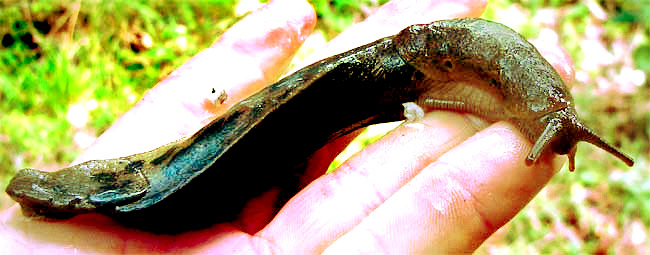Excerpts from Jim Conrad's
Naturalist Newsletter

from the May 10, 2009 Newsletter, issued from the Siskiyou Mountains west of Grants Pass, Oregon:
A REALLY BIG SLUG
Usually when Anita comes to my trailer bearing a container it contains something good to eat. However, Wednesday at dusk just after another rain what she had in her little bowl was something else, shown above.
That's a pretty big slug. At first I thought it was completely black but the next day in better light I saw traces of spotting on it, and I had to agree with Karen's assessment that probably it was the Great Gray Slug, Limax maximus, of which I've seen many in rainy Europe.
*UPDATE: In 2024, when I upload our image to iNaturalist, user "sagecrab" recognizes a particularly blackish Pacific Banana Slug, ARIOLIMAX COLUMBIANUS, which normally is a whitish slug with black splotches. Occurring on and inland North America's Pacific Coast, it's considered the second-largest species of terrestrial slug in the world, growing up to 25 centimeters (9.8 in) long. I read that the black spots can be so extensive that the slug seems a black one.
It's found in moist and damp areas of the forest floor, but eats a wide variety of herbaceous material and might sometimes eat garden plants. Various authors have reported that it also gnaws off its penis when disengaging from intercourse.
If Superglue didn't already exist I'd suggest that someone look into the mucous created by this slug, for it stuck to my fingers more than any animal product I've ever experienced.